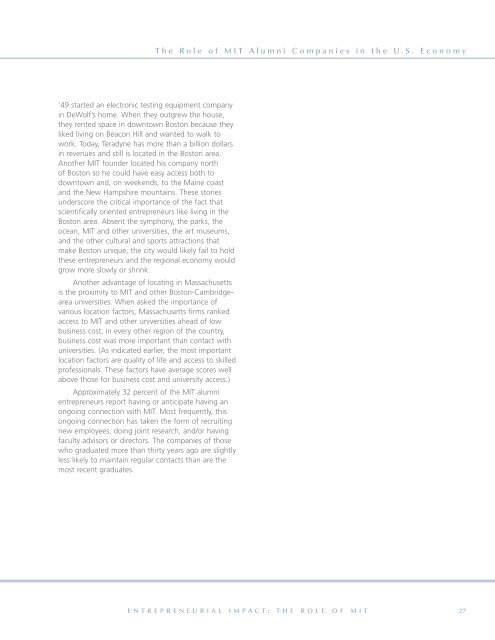mit_impact_full_report
mit_impact_full_report
mit_impact_full_report
You also want an ePaper? Increase the reach of your titles
YUMPU automatically turns print PDFs into web optimized ePapers that Google loves.
’49 started an electronic testing equipment company<br />
in DeWolf’s home. When they outgrew the house,<br />
they rented space in downtown Boston because they<br />
liked living on Beacon Hill and wanted to walk to<br />
work. Today, Teradyne has more than a billion dollars<br />
in revenues and still is located in the Boston area.<br />
Another MIT founder located his company north<br />
of Boston so he could have easy access both to<br />
downtown and, on weekends, to the Maine coast<br />
and the New Hampshire mountains. These stories<br />
underscore the critical importance of the fact that<br />
scientifically oriented entrepreneurs like living in the<br />
Boston area. Absent the symphony, the parks, the<br />
ocean, MIT and other universities, the art museums,<br />
and the other cultural and sports attractions that<br />
make Boston unique, the city would likely fail to hold<br />
these entrepreneurs and the regional economy would<br />
grow more slowly or shrink.<br />
Another advantage of locating in Massachusetts<br />
is the proxi<strong>mit</strong>y to MIT and other Boston-Cambridgearea<br />
universities. When asked the importance of<br />
various location factors, Massachusetts firms ranked<br />
access to MIT and other universities ahead of low<br />
business cost; in every other region of the country,<br />
business cost was more important than contact with<br />
universities. (As indicated earlier, the most important<br />
location factors are quality of life and access to skilled<br />
professionals. These factors have average scores well<br />
above those for business cost and university access.)<br />
Approximately 32 percent of the MIT alumni<br />
entrepreneurs <strong>report</strong> having or anticipate having an<br />
ongoing connection with MIT. Most frequently, this<br />
ongoing connection has taken the form of recruiting<br />
new employees, doing joint research, and/or having<br />
faculty advisors or directors. The companies of those<br />
who graduated more than thirty years ago are slightly<br />
less likely to maintain regular contacts than are the<br />
most recent graduates.<br />
The Role of MIT Alumni Companies in the U.S. Economy<br />
ENTREPRENEURIAL IMPACT: THE ROLE OF MIT 27



